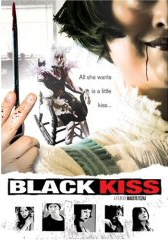
Director Macoto Tezka turns in a film as schizophrenic in its stylistic approach as it is warped in its themes. A brutally felt yet poetically formed snap shot of madness and art, Black Kiss (originally titled Synchronicity) merges elegance and shock with impressive depth of feeling. While lacking the structural unity so often seen in Asian Horror scripts, Black Kiss also lacks the imitativeness that is quickly turning a once unique sub-genre stale. This story of bizarre murder and body parts-as-art finds its own voice. If the labyrinthine twists and turns of the somewhat convoluted plot make it occasionally hard to follow, Tezka keeps the action fresh, perspectives chillingly amoral, and the atmosphere palpable. Released from Tokyo Shock, this may very well be the finest psychological horror film of the year.
The plot of Black Kiss is seeped in the stylistic and thematic conventions of traditional mystery/thriller and suspense films. Shades of Hitchcock, Polanski, and Forties Noir are evidenced in both the look and action of this menacing narrative. Mood is taken from Bava, Argento, and DePalma. But these conventions are used to lend color and spice to the story, not to BE the story. They are never allowed to overshadow the movie's originality. Asuka is the focal character, a model and dancer, finding herself homeless in Tokyo. She moves into an apartment that belongs to a 'friend's friend.' This third party, Kasumi, is haunted by her own emotional problems, and is easy to dislike. In true Hitchcock/Argento fashion, Asuka witnesses a gruesome killing across the street from Kasumi's apartment. Similar to Rear Window or The Bird With The Crystal Plumage, she is in the wrong place at the wrong time, and in an obvious nod to the Giallo witnesses a murder through her window, where she spots a woman dressed in black leather torturing a bound man with a scalpel. When the police arrive, they find him disembowelled, with metaphysical symbols carved into his flesh. Add to Asuka's character an inspector following up on a Cult angle and a brash young reporter, and you have a bristling handful of evocative if traditional suspense characters. As more deaths follow, and the mysterious moniker of 'the black kiss' appears next to them, it becomes apparent that the killer is performing a sinister sort of performance art, and that Asuka's own time may be coming . . .
Black Kiss is a creative and emotionally charged symbiosis of several cinematic genres, most notably the Giallo. Tezka includes all the red herrings, plot-twists, and enthusiastic murders that typify this particular art form, from the character-types (detective, reporter, black-garbed killer) to the fetishistic violence and general spectacle surrounding violent murder -- although it should be noted that many of the murders are presented after the fact, deviating from Giallo formula). Just as crucial is the role of Asuka, who fit's the traditional archetype of the 'Outsider' character, who through coincidence or curiosity becomes embroiled in dangerous cat-and-mouse games with psychotic murderers. In her increasingly intimate relationship with investigation, and her status as an Outsider, she is a perfectly realized contemporary Gialo-type heroine. However, she is also her own persona, with a carefully layered personality and arc of development. She is an honest to god character that we can believe in and feel for, not simply a 'role.' Likewise, although the film shows similarities with the Giallo and traditional suspense thriller, the plot, the way in which the themes are explored, and the atmosphere are each unique in temperament. In fact, the film has fun with its homage, using Hitchcock names in its locations, etc. A grim, doom-laden mood surrounds the story, soaking through the sets. And while some claim that the film goes too many places at once, it is precisely this sense of adventure -- this willingness to defy convention with spiralling sub-plots and visual orgies of mood -- that make it stand out in an age where most films simply imitate other movies. Serious, horrific, and shocking, Black Kiss delivers a bloody wet one right across the face of the genre.
Tokyo Shock features Black Kiss in an aspect ratio of 1.85:1, enhanced for anamorphic televisions. The print is wonderful to look at, capturing the intensity and depth of the characters and set-pieces. Skin tones are realistic, while the colors are vibrant and seductive. While most of the film emphasizes the dark blacks and cold grey of Noir, the physical carnage is splashed loudly across the screen, making the experience that more unsettling. Audio is offered in Japanese with English Sub-titles. Extras, as is usual for Tokyo Shock, are a killer's palate of fact and fun. Deleted Scenes add some perspective and are fun but it is easy to see why they were cut out. Mystery of Black Kiss and Truth of Black Kiss are above average segments that go in depth into the making of the film, incidents paralleling the story, and assorted gossip and opinions that lend the film greater social and aesthetic context. An average Still Gallery is next, followed by Theatrical Trailers.
Review by William P. Simmons
| Released by Tokyo Shock |
| Region 1 - NTSC |
| Not Rated |
| Extras : |
| see main review |